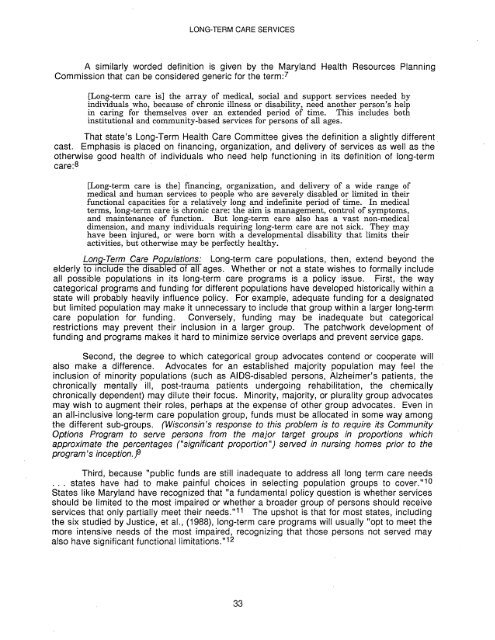long-term care - Legislative Reference Bureau
long-term care - Legislative Reference Bureau
long-term care - Legislative Reference Bureau
Create successful ePaper yourself
Turn your PDF publications into a flip-book with our unique Google optimized e-Paper software.
LONG-TERM CARE SERVICES<br />
A similarly worded definition is given by the Maryland Health Resources Planning<br />
Commission that can be considered generic for the <strong>term</strong>:?<br />
[Long-<strong>term</strong> <strong>care</strong> is] the array of medical, social and support services needed by<br />
individuals who, because of chronic illness or disability, need another person's help<br />
in caring for themselves over an extended period of time. This includes both<br />
institutional and community-based services for persons of all ages.<br />
That state's Long-Term Health Care Committee gives the definition a slightly different<br />
cast. Emphasis is placed on financing, organization, and delivery of services as well as the<br />
otherwise good health of individuals who need help functioning in its definition of <strong>long</strong>-<strong>term</strong><br />
<strong>care</strong>: 8<br />
[Long-<strong>term</strong> <strong>care</strong> is the] financing, organization, and delivery of a wide range of<br />
medical and human services to people who are severely disabled or limited in their<br />
functional capacities for a relatively <strong>long</strong> and indefinite period of time. In medical<br />
<strong>term</strong>s, <strong>long</strong>-<strong>term</strong> <strong>care</strong> is chronic <strong>care</strong>: the aim is management, control of symptoms,<br />
and maintenance of function. But <strong>long</strong>-<strong>term</strong> <strong>care</strong> also has a vast non-medical<br />
dimension, and many individuals requiring <strong>long</strong>-<strong>term</strong> <strong>care</strong> are not sick. They may<br />
have been injured, or were born with a developmental disability that limits their<br />
activities, but otherwise may be perfectly healthy.<br />
Long-Term Care Populations: Long-<strong>term</strong> <strong>care</strong> populations, then, extend beyond the<br />
elderly to include the disabled of all ages. Whether or not a state wishes to formally include<br />
all possible populations in its <strong>long</strong>-<strong>term</strong> <strong>care</strong> programs is a policy issue. First, the way<br />
categorical programs and funding for different populations have developed historically within a<br />
state will probably heavily influence policy. For example, adequate funding for a designated<br />
but limited population may make it unnecessary to include that group within a larger <strong>long</strong>-<strong>term</strong><br />
<strong>care</strong> population for funding. Conversely, funding may be inadequate but categorical<br />
restrictions may prevent their inclusion in a larger group. The patchwork development of<br />
funding and programs makes it hard to minimize service overlaps and prevent service gaps.<br />
Second, the degree to which categorical group advocates contend or cooperate will<br />
also make a difference. Advocates for an established majority population may feel the<br />
inclusion of minority populations (such as AIDS-disabled persons, Alzheimer's patients, the<br />
chronically mentally ill, post-trauma patients undergoing rehabilitation, the chemically<br />
chronically dependent) may dilute their focus. Minority, majority, or plurality group advocates<br />
may wish to augment their roles, perhaps at the expense of other group advocates. Even in<br />
an all-inclusive <strong>long</strong>-<strong>term</strong> <strong>care</strong> population group, funds must be allocated in some way among<br />
the different sub-groups. (Wisconsin's response to this problem is to require its Community<br />
Options Program to serve persons from the major target groups in proportions which<br />
approximate the percentages ("significant proportion ") served in nursing homes prior to the<br />
program's inception.j9<br />
Third, because "public funds are still inadequate to address all <strong>long</strong> <strong>term</strong> <strong>care</strong> needs<br />
... states have had to make painful choices in selecting population groups to cover."i0<br />
States like Maryland have recognized that "a fundamental policy question is whether services<br />
should be limited to the most impaired or whether a broader group of persons should receive<br />
services that only partially meet their needs."11 The upshot is that for most states, including<br />
the six studied by Justice, et aI., (1988), <strong>long</strong>-<strong>term</strong> <strong>care</strong> programs will usually "opt to meet the<br />
more intensive needs of the most impaired, recognizing that those persons not served may<br />
also have significant functional limitations."12<br />
33
















